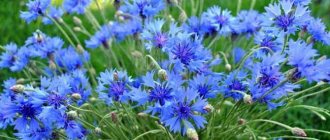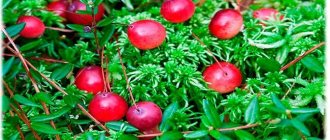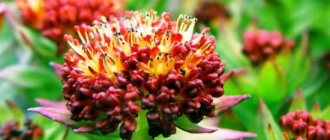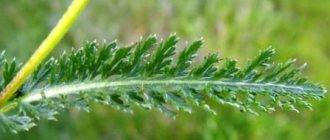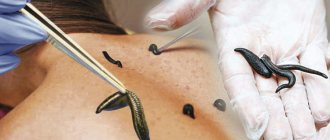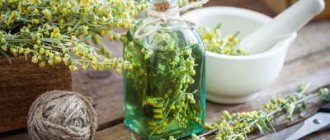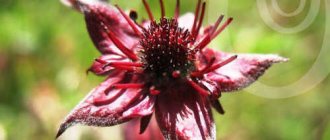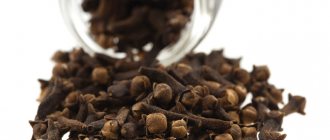Gooseberry is a very common plant, widely used in the national economy as food for large horned animals and bees, as well as a food additive. In folk medicine - as an effective anti-inflammatory, antispasmodic, choleretic and sedative.
The word “goat’s foot” is literally translated as “goat’s foot”, since there is a visual similarity in the shape of the leaves and the hoof print. Since ancient times, in Rus', young shoots of the honeyweed were used as food (mainly in early spring, when food supplies ran out).
Our ancestors greatly valued squash for its nutritional properties and used it as a main dish in times of famine (cooked, dried and fermented). Therefore, some consider the similarity of the expressions “to eat” and “food” to be no coincidence.
Fresh leaves and stems contain 85% water, 1.7% protein, 1.4% carbohydrates, 1.3% fiber. 100 grams of the plant contains 12.5 calories.
Where can I meet and how to find out
Rot is so common that in Europe and Asia it can be found almost everywhere! You can find it among both deciduous and coniferous trees.
In thickets of bushes, in parks, forests, ravines, along roads, in gardens and vegetable gardens. Well-moistened soil with any composition is enough for her. It can grow both in the sun and in dense shade. Snitch is absolutely unpretentious.
For such unpretentiousness, omnipresence and the ability to spread its roots in all directions (including to a depth of up to a meter) along the ground, gardeners do not like it so much. To prevent the borer from crowding out all the cultivated plants on the site, they wage a constant struggle with it, often to no avail.
The borer is a bright representative of the Umbrella family. It can be recognized by its straight tubular stem (from 50 centimeters to a meter in length), trifoliate leaves, and small white flowers (collected in a characteristic “umbrella”).
Flowering can be observed in June-July, after which small brown berries appear in place of the flowers.
Botanical description
Snot is a herbaceous perennial from the Apiaceae family. It has a long creeping rhizome, which produces numerous root shoots, making it prone to aggressively capturing new territories.
In the close-up photo of the dream, you can see the weakly branched, bare, grooved stem, hollow in cross-section. The height of the bush on fertile soils can reach 100 cm, but usually does not exceed half a meter. The leaves are trifoliate or tripinnate, ovate-oblong, pointed at the end, with serrated, sharply jagged edges. The upper part of the leaf is bare, the lower part has short pubescence. The petioles of the lower tier are long, those of the upper leaves are shorter, and they themselves are less dissected.
It blooms only in open areas, under the forest canopy or in shady corners of the site; this rarely happens; reproduction in this case occurs exclusively by vegetative means.
The umbrella-type inflorescence includes up to 2-3 dozen rays, at the ends of which small whitish flowers with five oval-heart-shaped petals open. At the end of flowering, oblong seeds-fruits 3-4 mm in size ripen. The apical umbrella inflorescence is always larger than the others.
Drowning grass is a long-lived herb. If we consider all the growth from one bush as a single specimen, then it can occupy a very significant territory and live in one place for at least half a century.
Chemical composition
Our ancestors knew for a long time that borer has high nutritional properties. According to modern folk healers, its chemical composition is similar to the formula of human blood. They claim that this plant has a rich biological composition that is very beneficial for humans.
Among them:
- Polyacetylenes (natural pesticides with pronounced antifungal properties). Due to this, the leaves of the tree can be used to prevent food spoilage. These same substances are actively used in experimental medicine as an antitumor component.
- Amino acids that take part in redox processes.
- Essential oils with pronounced antiparasitic properties.
- Flavonoids, which have a beneficial effect on the urinary system, demonstrate anti-inflammatory and antiallergic properties.
- Carotene (vitamin A), which has an antioxidant effect, promotes skin regeneration and slows down the aging process.
- Coumarins (natural antibiotics with anti-inflammatory and analgesic properties). Take part in activating hair growth.
- Polypeptides that take an active part in carbohydrate metabolism.
- Saponins. Actively stimulate secretory function and intestinal motility.
- Steroids affecting cholesterol metabolism.
- Organic acids. They demonstrate antioxidant, choleretic, diuretic, anti-inflammatory and antitoxic properties, stimulating the immune system.
- Choline, which takes part in lipid metabolism and has a hepatoprotective effect.
- Phytoncides, which are excellent immune stimulants, have antibacterial, antiviral and antifungal properties.
- Complex of vitamins and microelements. This herb (especially young) is a source of many beneficial substances, thereby stimulating the immune system and strengthening the body.
Such a rich chemical composition of honeydew makes it indispensable in the practice of traditional medicine.
Medicinal properties
Alternative medicine considers honeydew to be an indispensable plant for general health, prevention and treatment of a number of diseases. It has the following effects on the body:
- Anti-inflammatory (fights inflammatory processes in the gastrointestinal tract, muscles, blood vessels, joints).
- Used for gastritis, arthritis, gout, neuralgia.
- Antitumor. According to naturopaths, the dream contains substances that can fight cancer cells, and therefore fight cancer (reduce metastases, slow down the growth of tumors, support after chemotherapy).
- Hepatoprotective. Activates the process of restoration of liver cells - hepatocytes, regulates lipid metabolism, improves metabolism.
- Antibacterial. Fights pathogenic microflora (viruses, bacteria, fungi). Shows bactericidal properties when used externally (nail fungus, bedsores, skin ulcers).
- Intoxicating. Blocks the production of free radicals, removes toxins and salt deposits.
- Choleretic. Helps to establish the processes of formation and excretion of bile, relieving spasm of the bile ducts. What is the prevention of cholecystitis and dyskinesia of the gallbladder.
- General strengthening. Due to the high content of vitamins and microelements, it takes part in redox processes and has a general strengthening and rejuvenating effect on the body. Can be used to strengthen the body after illnesses.
- Antihypoxic. Strengthens the walls of blood vessels, increases their tone, promoting normal blood flow.
- Antiscorbutic. Due to the high content of ascorbic acid, it has an antioxidant effect. It prevents colds, acute respiratory infections, and scurvy.
- Diuretic. Improves blood circulation, helps fight edema due to heart and kidney pathologies.
- Sedative. The essential oils contained in the plant have a calming effect. Can be used under high physical and emotional stress. Helps strengthen memory.
- Painkiller. Reduces inflammation, helps with pain in muscles and joints. Healing. Stimulates regenerative processes, especially in relation to the skin.
Also, it helps lower blood pressure, remove toxins from the body, and can be used as one of the components of a diet for weight loss.
Indications for use
Due to its rich chemical composition and complex of medicinal properties, representatives of alternative medicine recommend pine to help externally and internally with the following diseases and conditions:
- tumors;
- atherosclerosis;
- avitaminosis, scurvy;
- renal pathologies;
- gastrointestinal diseases;
- gallbladder pathologies;
- gout, arthritis, arthrosis, rheumatism, myositis;
- decreased hemoglobin;
- problems with the nervous system;
- neuroses, insomnia;
- diseases of the cardiovascular system;
- blood pressure;
- iron deficiency anemia;
- decreased appetite;
- pain of any nature (primarily joint pain);
- for wound healing;
- fungal diseases;
- diathesis;
- swelling.
For women's health
Sleeping is a great help for women who want to maintain health and beauty. So, it is recommended to use it to maintain and preserve youthful facial skin. For this purpose, masks are used to which gruel or juice of young leaves is added.
It is believed that such masks help improve skin elasticity and reduce wrinkles. And to achieve an even greater effect, it is recommended to add a little olive oil to the mask.
For even additional tone and rejuvenating effect, the juice from young leaves of the dream can be mixed with clean water (in equal parts) and frozen in the form of cubes. It is recommended to wipe your face with these cubes every morning.
And to cleanse your skin in the evening, you can use a paste of leaves and cucumber.
You can add the juice of fresh leaves to hand cream (to moisturize the skin) and shampoo (to make your hair silky)
For health after 50 years
After 50 years, certain diseases often appear, chronic illnesses make themselves felt, so our health requires a more careful approach.
One of the main problems is general slagging. To avoid it, representatives of alternative medicine recommend regular cleanings.
For this purpose, borer (its young shoots) can be used. To prepare the cleanser, the shoots are washed well, doused with boiling water and ground in a meat grinder. The juice is squeezed out of the resulting pulp, diluted with boiled water and taken for 10 days according to the following scheme:
- Day 1: mix 1.5 tablespoons of juice with the same amount of water and drink a tablespoon 3 times 20 minutes before meals;
- Day 2: mix 3 tablespoons of juice with the same amount of water and drink 2 tablespoons 3 times 20 minutes before meals;
- Day 3: drink undiluted juice, 1 tablespoon 3 times 20 minutes before meals;
- Day 4: drink undiluted juice 2 tablespoons 3 times 20 minutes before meals;
- Days 5-10: undiluted juice is drunk 50 grams 3 times 20 minutes before meals.
It is important to monitor your body's reactions throughout the cleansing period. And, if allergic reactions occur, stop taking the cleanser immediately.
From the first day of taking the juice, you need to monitor your well-being and if allergic reactions occur, the procedure should be stopped.
Sick from alcoholism
Traditional healers recommend using snyt in situations where it is necessary to get a person suffering from alcohol addiction out of binge drinking. And all thanks to the plant’s ability to remove toxins and have a beneficial effect on the functioning of the renal system and liver.
To help alcohol addicts, prepare a tonic drink (3 teaspoons of fresh herb, pour half a liter of boiling water and leave for 2 hours under a tightly closed lid). This infusion should be strained and drunk 4 times a day, 100 grams an hour before meals.
To quickly overcome addiction, naturopaths also recommend chewing the seeds of the dream regularly.
Contraindications
The only contraindication known today is individual intolerance to sleep. There have been no cases of plant overdose or related problems. The plant even exerts its laxative effect gently, without causing unnecessary inconvenience.
There is no reliable data on the advisability of use during pregnancy and breastfeeding. Therefore, it is recommended to approach the use of the plant with caution during these periods. The same applies to the use of the plant by children.
How to use snot
In the practice of alternative medicine, all parts of the plant are used (both fresh and dried).
Here are the main features of using dream:
- Freshly squeezed juice. For its preparation, young and juicy shoots are used. The juice can be used to treat diseases of the gastrointestinal tract, liver, kidneys, and bladder (it is recommended to take it with honey in a ratio of 50 grams of juice and 1 teaspoon of honey). Dreamweed juice is also used to prepare pain-relieving compresses (for the treatment of rheumatism and skin problems).
- Fresh fruit can be added to food (for example, salads) to combat vitamin deficiency, anemia, constipation and swelling. For scurvy, fresh young leaves should be chewed slowly. Fresh leaves are also suitable for use in the form of compresses, which have anti-inflammatory and analgesic effects.
- In its dried form, it is used to prepare decoctions and infusions. Infusions can be used as compresses for joint pain. Decoctions are taken for hypertension, vascular diseases, diabetes, allergies, and infectious diseases.
- The roots of the plant are suitable for making decoctions (added to baths to eliminate dermatological problems and have a sedative effect on the nervous system).
Reviews
To my taste, squash boiled in soup adds a fishy flavor to the dish. Not everyone likes this taste, but I liked it. But first blanched and then fried with nettles, it tastes similar to mushrooms. If you combine this vitamin-rich fry with boiled potatoes, you won’t be able to tear anyone away from this food by the ears.
Angela, 31 years old, Vyazma
There is nothing worse than whining in the garden, except that wheatgrass can compare with it. I spent several years, real years (from April to September) fighting these herbs. Until she turned over layer by layer all the areas with weeds, until she took all the roots out of the ground with her own hands, until she drove these herbs out of the center of the garden and under the fence. It doesn’t bother me to snoop there, but I will continue to fight the wheatgrass.
Svetlana, 28 years old, Lipetsk
Natalia
Author
Ask a Question
Many careful and caring owners manage to live without weeds in their gardens. But sometimes you still need to think about whether it is really necessary to get rid of all the weeds. What if at some point they become our saviors? Health to you and your loved ones!
Preparation and storage
The squash is harvested from the end of April to the end of August. Particular attention should be paid to young plants (which are considered the most useful and are collected in the spring). Those who usually pay attention to the lunar calendar can be recommended to do the preparation in the phase of the young Moon.
They say that it is during this period that all the beneficial juices are concentrated in the shoots.
The process of preparing dried honey includes the following steps:
- Collection (collection means mowing dry plants or digging them up along with the roots).
- Preparing the sap (it should be carefully sorted out, if necessary, damaged shoots or parts of the root should be removed, washed under running water).
- Drying plants. The shoots are laid out or hung in a dry, well-ventilated place (avoiding direct sunlight) and dried until completely dry, turning over periodically.
- The roots are cut into smaller pieces before drying. An alternative to natural drying is drying in an electric dryer (at low temperatures).
- Storage. Dried mushrooms are stored and used throughout the year in fabric or paper bags in ventilated areas. It can also be stored in the form of ground powder.
Use as a honey plant
The gooseberry is an excellent honey plant. During the entire flowering period, it collects bees and other insects to collect nectar. The honey productivity of the planting is estimated at 240 kg of honey per hectare, maximum values are achieved in warm and humid weather. The approximate daily weight gain of one hive can be 3-4 kg. During a month of active collection, it reaches 30-40 kg.
Preparation of medicines
Let's consider the most common uses (and recipes for preparation) of dream in the form of medicines.
- Alcohol tincture from the roots (used to treat gastrointestinal diseases and cancer). It is prepared like this: well-washed roots are crushed in a meat grinder and placed in a liter jar (filled about a third); pour vodka (another 2/3) and close tightly; insist for two weeks; filter well; drink 3 times a day, 25 drops 30 minutes before meals.
- An infusion of shoots of sedum (used for diseases of the joints, kidneys, gastrointestinal tract, liver). To prepare it you need to: pour boiling water over two tablespoons of herbs, leave for 15 minutes, then wrap, leave until completely cool, strain, add a glass of boiled water. Drink for two months 3 times a day before meals.
- An infusion of the roots of the dream (used for thrombosis, atherosclerosis and blood disorders). Place a tablespoon of roots in boiling water (about a glass) and cook over low heat for about 20 minutes. Once it cools down, leave for 6 hours, strain and drink throughout the day in equal parts.
- Dream compresses (used for wounds, bedsores, joint pain). To prepare a compress, chopped fresh (or, in the absence of fresh, dry) herbs are placed on gauze, tied and placed in boiling water for 5 minutes. Cool to a comfortable temperature and apply to the affected areas for 30 minutes.
Soothing baths (used for stress, insomnia, loss of strength, rheumatism). To prepare a decoction for baths, pour 40 grams of finely chopped roots with boiling water and leave for 15 minutes. The broth is filtered and added to the bath. You can wash your hair with the same decoction to make it grow better.
Common borer - a new essential oil plant, its economic and medical significance (review)
Fedotov S.V. Common goosefoot - a new essential oil plant, its economic and medical significance (review). pp. 69-79. On Sat. “Aroma correction of a person’s psychophysical state.” Materials of the V International Scientific and Practical Conference (Yalta, October 27–29, 2015). Yalta: 2015, 113 p.Fedotov Sergey Viktorovich1
1 Real LLC - Center for PhytoAromaTherapy, St. Petersburg
194044, Bolshoi Sampsonievsky Prospekt, 48-b
The data on the economic importance of the common honeydew (Aegopodium podagraria L.) and its potential as a medicinal, food, fodder, vitamin-bearing, melliferous and essential oil crop are summarized.
Key words:
common warbler;
Aegopodium podagraria L.; essential oil; phytoncides; biological activity. Genus Aegopodium
is represented by 7 species, of which three grow on the territory of Siberia: common gooseberry, alpine gooseberry, and broadleaf gooseberry.
Of all the species in Central Russia, the most common is the common duckweed ( A. podagraria L.
). This plant, despite its ubiquitous presence in European Russia, is rarely considered beneficial. Even before the middle of the last century, it was more often mentioned as a weed [1] and less often as an edible plant [2]. As a medicinal raw material, it fell out of sight of domestic official medicine more than 150 years ago. In books about medicinal plants, it began to appear occasionally again only from the late 50s. last century. And this is all despite the fact that the excellent taste properties of the common dream have been valued by connoisseurs of the green world at all times (the first mention of the dream is in a manuscript dating back to the 12th century). At the same time, traditional medicine has never excluded this plant from among its healing agents. But only biochemical and applied research in recent decades have been able to substantiate the biological effect of edible dream (as it was called back in the mid-19th century). But we are yet to become acquainted with the pine tree as an essential oil plant and the biological activity of its essential oil.
Now that the process of formation and development of new enterprises has begun, the main activity of which is essential oil production, in conditions of shortage of acreage and planting material, it makes sense to pay attention to the surrounding plant resources. Common moth may be one of such resources, the demand for essential oil of which can be quickly increased due to the actively developing interest in aromatherapy in our country and the market for products that provide this direction. The pleasant aroma of essential oil and its biological activity will be of interest both to those who prepare fragrant perfume compositions and to those who practice aromatherapy. And with an integrated approach - combining a processing enterprise and other types of activities (beekeeping, livestock farming, harvesting greens and roots), the profitability of this crop can significantly increase.
Common borer
(snitka, edible duckweed, goat's leg, marsh sage) -
Aegopodium podagraria L.
(from the Greek
aegos
- goat and
podion
- leg, and the species name
podagra
is a derivative of gout or rheumatic pain in the legs, for which this plant was used).
Perennial herbaceous plant 30-120 cm high of the celery (umbelliferous) family - Apiaceae (Umbelliferae
). The stems of the tree are hollow inside (vacuform), glabrous or softly pubescent, slightly furrowed, branched in the upper part. The plant has two types of leaves: lower basal and upper stem. The lower basal leaves are double-triple, located on long
| Common borer (Flora von Deutschland Österreich und der Schweiz, 1885) |
(up to 40 cm), hollow petioles. The upper stem leaves are trifoliate, smaller and located on short petioles widened in the sheaths. Leaf blades with a sharply serrated edge, ovoid with a pointed apex, pubescent along the veins on the underside, 10-20 cm long, 10-25 cm wide. The rhizome is horizontal, long, creeping, with adventitious roots, and can penetrate deeply into the ground (up to 0.5 m).
Blooms in the middle zone in June-July. The flowering shoot bears several multi-rayed umbels with small white (sometimes pinkish), pleasantly scented flowers with 5 petals. The flowering period lasts about 30 days. Fruits in July-August. Seeds that fall to the ground germinate in May. Numerous oblong, brown fruits of the dvosemyanka are 3-4 mm long and 3 mm wide, slightly compressed from the sides. Thanks to the abundance of seeds (up to 500-800 on one plant), as well as the large number of buds (up to 6000) on the rhizomes, the aquifer is capable of quickly multiplying and capturing new territories [3], suppressing existing vegetation. This feature makes it difficult to eradicate, which causes serious inconvenience for summer residents who consider it primarily as a weed. After all, even a plant torn out of the ground thrown onto a compost heap or a piece of its root can produce new shoots.
In garden plots, the best way to inhibit the spread of borer, without the use of herbicides, is to tear off flowering shoots at the beginning of their flowering and carefully collect even small roots during spring-autumn digging of the earth. Collected roots and plucked or torn parts of plants are best disposed of in separate barrels, in which everything rots over the course of a year. Personal experience has shown that burning them provides the greatest effectiveness in combating the disposal of roots and flowering shoots.
The plant loves shady and humid places, grows in mixed, birch and coniferous forests, on the edges, in ravines, meadows, and along roadsides. At the same time, in shady places the plant does not bloom, but forms a thick cover of basal leaves.
100 g of the above-ground part of the plant contains 39-44 mg of vitamin C in June-July and 65-109 mg in August-September [4,5]. Among the micro- and macroelements found in snyti: Fe (16.6 mg%), Mg (13 mg%), K (3.8-8.3 mg%), B (3.9 mg%), Cu ( 1.99 mg%), Ti (1.68 mg%), as well as: Ca, Si, P, Al, Mo, V, Ga, Zn.
Young greens contain up to 3% fat [6]. Unsaturated and saturated fatty acids have been identified in its composition: palmitic, stearic, oleic, linoleic, arachidonic [7,8]. The lipophilic fraction also contains chlorophylls and carotenoids, which demonstrate pronounced antioxidant and bactericidal effects and promote regeneration [7,8].
Polyacetylene compounds were found in the underground and above-ground parts of the plant: falcarinolone, falcarinol, falcarindiol, falcarinone, cis-heptadeca-1,8-diene-4,6-diine-3,10-diol, heptadeca-1,5-diene-4, 6-diyne-3,10-diol, cis-10-acetoxyheptadeca-1,8-diene-4,6-diyne-3-ol, trans-10-acetoxyheptadeca-1,8-diene-4,6-diyne- 3-ol, cis-heptadeca-1,9-diyne-3-ol-8-one, (2-cis, 9-cis)-heptadeca-2,9-diene-4,6-diyne-1-ol; aliphatic hydrocarbons, alcohols, aldehydes, ketones: 3-methylbutanol, heptanal, octanyl, nonanal, decanal, nonan-2-one, 6,10-dimethyl-5,6-undecadien-2-one, in the underground part - pentadecane; coumarins: umbelliferone, in the underground part - angelicin; phenolcarboxylic acids in the underground part: caffeic, chlorogenic; nitrogen-containing compounds: choline; saponins; essential oil in stems (0.02-0.06%), leaves (0.04-0.07%), fruits (0.04%).
Carbohydrates were found in the inflorescences: umbelliferose, glucose, fructose; phenolcarboxylic acids: caffeic; flavonoids: quercetin, kaempferol, kaempferol diglycoside; nitrogen-containing compounds: choline; essential oil (0.14%) [9,10].
Polyacetylene compounds (falcarinol, falcarindiol) found in the above-ground and underground parts of the plant have a pronounced fungicidal (antifungal) effect due to their cytotoxic properties [11]. Their antitumor activity in vivo has been confirmed. The flavonoids quercetin and kaempferol have diuretic activity [12].
Common moth is a good honey plant. Young leaves have long been used for food purposes - added to salads, okroshka, soups, stewed with onions and potatoes, pickled, fermented. In Moldova, young shoots, unblown leaves and petioles are used instead of cabbage, for example, in cabbage soup. When dried, it is added to prepared dishes as an aromatic spice. The literature describes many recipes for various dishes using dreamy [13,14,15, etc.]. Chickweed is one of the first to appear in the spring, so its tender young shoots, with such a rich mineral and vitamin composition, are a very important additive to food, capable to a certain extent of replenishing the supply of nutrients in the body that has been depleted over the winter. And the high content of iron, copper and manganese allows it to be prescribed in medical nutrition for certain forms of anemia [16]. The antihypoxic effect of honeydew is associated with the presence of biologically active substances in it, such as flavonoids, carotenoids, citric and malic acids, which in combination with vitamins and microelements (copper, magnesium, selenium, zinc, etc.) increase resistance to oxygen deficiency (hypoxia) .
The identified antioxidant properties of the common pine tree made it possible to recommend it as a 3% vitamin supplement for inclusion in poultry meat recipes, for example, meat cutlets. Such a herbal additive allows not only to significantly increase the organoleptic characteristics of the product and enrich its vitamin and mineral composition, but also to significantly increase the shelf life of the semi-finished product [17]. The antioxidant properties of the plant are provided by the carotenoids, citric and malic acids it contains, polyphenolic compounds, phytoncides and a high content of vitamin C. These substances are well preserved in the plant for a long time when frozen in the refrigerator, with some loss when dried, but are easily destroyed when exposed to heat. processing.
If for food purposes the young leaves of the plant are mainly used, then for medicinal purposes the entire above-ground part is used, and occasionally the roots of the plant. For medicinal purposes, the plant is harvested during its flowering period; the roots are dug up after flowering has ended. The dried aerial parts are stored in a closed glass container, and the roots in a wooden container.
Annenkov N. (1878) in the “Botanical Dictionary” pointed to the former use of dream in official medicine for gout - “... which is why the species name of the plant.” Goretsky and Vilk (1892) in their “Russian Folk Medicinal Herbalist and Flower Garden” wrote that the herb was applied in the form of a poultice to sick “... members with gout, as it has a softening and slightly diluting effect.” However, after the advent of more effective medicinal preparations, pine as a medicine was forced out of pharmacology, but continued to be used in folk medicine.
In folk medicine, the leaves of the common dream are used as an anti-inflammatory, antihypoxic, astringent, antiscorbutic, detoxifying, diuretic, analgesic, tonic, emollient, choleretic, sedative, wound-healing, fungicidal agent [8,18,19, 20, 21, 22, 23, etc. .].
Zemlinsky S. pointed out the use of snot for rheumatism [4].
Shtygol S. et al. refer to the prospects of using dreamy to reduce the general toxic effect of antitumor drugs, and as a sedative for neuroses [8].
Pastushenkov L. et al. write about the enhancement of the detoxification function of the liver by drugs [24].
An infusion of dreamweed (3 teaspoons in 2 cups of boiling water, infused for 2 hours and taken half a glass 4 times a day before meals) is recommended for joint damage, gastrointestinal diseases accompanied by disorders of the digestive tract (diarrhea and constipation), kidney diseases and bladder [18, 19, 20, 21, 25, etc.]. An infusion brewed from fresh young herbs is taken in the spring as a vitamin drink for faster recovery after the past winter.
It is used fresh as an antiscorbutic remedy for hypovitaminosis and iron deficiency anemia. As a source of vitamins A, C, and microelements necessary in winter, the sow is salted (60 g of salt per 1 kg of goose), dried, canned, pickled, frozen and stored in a cool place [13, 14, 26, etc.].
In the form of compresses, crushed leaves (or their decoction) are applied to sore spots for burns, insect bites, wounds, rheumatism and pain in joints and muscles [27, 28].
Juice squeezed from the above-ground part of a young plant is recommended for gastrointestinal diseases, diseases of the kidneys and bladder, respiratory tract, poisoning, dizziness, as a diuretic and emollient (1/4-1/3 cup with 1 tbsp. spoon of honey) [28].
Shchadilov E. recommends using baths from the roots of the dream in the treatment of myositis and polyarthritis. To prepare a bath, the author advises using a decoction of the roots of the nymph (pour 40 g of roots with 1 liter of boiling water, boil for 10 minutes, then strain the decoction and pour into a bath with a water temperature of 36-37ºC) [29].
An alcoholic infusion of the roots and leaves of nymph (1 part of the roots is infused with 3 parts of 40% alcohol for 10-15 days) is taken for diseases of the digestive organs, kidneys, bladder, prostate gland and appendages, sore throat, cystitis, stomach ulcers, gastritis and colitis (20-25 drops 3 times a day 20 minutes before meals). Infusions are also used for headaches and joint diseases. For external use, the infusion is diluted with water in a 1:1 ratio.
Dryweed is used in folk medicine in other countries.
In Poland, infusions of the aerial part of the plant are used for rheumatism, diseases of the digestive system, respiratory tract, gout, arthritis, and as a detoxifying agent [30].
In Abkhazia, honey leaves are used for erysipelas and exudative diathesis [31].
In Armenia, gout is used in homeopathy for gout, wounds and rheumatism [32].
In England, since the Middle Ages, gooseberry has been grown in monastery gardens as a cure for gout, sciatica and rheumatism. One of the local popular names for snot, “bishops’ grass,” is associated with the fact that it was this category of people who very often developed gout, apparently due to the characteristics of the diet, which was replete with meat and alcohol. Young leaves are used externally to heal bruises and abrasions. Used internally for sciatica [22, 33]. The anti-inflammatory effect of herbal preparations is noted in the British Herbal Pharmacopoeia (1996).
Currently, work has been carried out to develop the composition and technology of tablets based on a dry extract from the herb Aegopodium podagraria and their standardization [34]. A dry extract of the aerial part of the common nymph, standardized for phenolic compounds, increases diuresis mainly due to an increase in glomerular filtration rate, and the tincture inhibits tubular reabsorption [12]. The ability of dry extract of sedum has been established to reduce the degree of pathomorphological changes in liver cells during polychemotherapy [35].
Moleweed can dye wool and fabrics green (greenish-yellow) or yellow (orange), which is why it was previously used as a dyeing material. The final color depends on the degree of mordant, and repeated dyeing can bring it to brown [33, 36].
The plant has a peculiar, rather pleasant aroma. As N. Verzilin pointed out in the book “In the Footsteps of Robinson,” the first edition of which was published in 1947, in the old days, greengrocers used to put honey in vegetables to give them a unique smell. It is only now that it has been established that the volatile secretions of honeydew can not only add flavor, but also significantly increase the shelf life of vegetables.
However, it is precisely this smell that some animals do not like, which are reluctant to eat fresh gooseberry on pastures, but consume it after ensiling [37]. In its fresh form, this plant is eaten by rabbits, sheep, and in small quantities by cattle, and after steaming or in the form of chaff, by pigs.
Volatile secretions of the common moth have a pronounced insecticidal effect against Varroa mites – Varroa destructor
, parasitizing honey bees and causing their mass death. To combat mites, beekeepers using “bottomless” hives (hives with a removable top and no bottom) scatter freshly cut crushed gooseberry on a mesh, which, after removing the roof of the hive, is placed on top, and the mesh is covered so that the grass phytoncides do not evaporate quickly, but went to the hive. A trap tray for ticks is placed below, onto which they fall.
By the way, along with the common weed, the effect of volatile secretions of several other plant species that have phytoncidal activity and contain essential oils on ticks was studied.
The experiment also involved freshly cut and crushed leaves of horseradish ( Armoracia rusticana P.
), felt burdock (
Arctium tomentosum Mill.
), black currant (
Ribes nigrum L.
), herbaceous parts of wormwood (
Artemisia absinthium L.
), wormwood (
Artemisia vulgaris L.
), tansy (
Tanacetum vulgare L.
), parsley garden (
Petroselinum sativum Mill.
). The greatest efficiency, expressed in the number of mites collected from a trap when processing one hive, was demonstrated by common weed (three times higher than the next in these indicators by parsley and horseradish), and the least by tansy.
The common gooseberry grows in all regions of Europe and the European part of Russia, Western and Eastern (Angara-Sayan region) Siberia, Central Asia, the Caucasus, Turkey, the USA, etc. [2, 33, 38, 39]. Due to its unpretentiousness, vitality, high fertility, and the ability to quickly develop new territories, including with the help of humans, the borer gradually expands its growing area, displacing native plants. In this regard, the gooseberry is recognized as an invasive plant, for example, in Armenia, where in 2007 there was a case of importation of a plant species new to the Artik region of the Shirak region - the gooseberry. It was brought by a local resident along with other ornamental plants in a coma of earth from the Moscow region. In the same year, intensive reproduction of the dream was recorded on the owner’s plot, which could not but cause serious concern among local biologists. They faced a dilemma - to remove this interesting species of medicinal, melliferous and vitamin-bearing, forage and food plant, or to leave this malicious, aggressive, difficult to eradicate weed while it has a relatively local distribution [46].
The alarm of biologists is understandable, because the pine tree can be confidently classified as a group of so-called plants – edificators, i.e. “creators”, “builders” of communities; it is a plant with a pronounced environment-forming ability, which to a certain extent influences the species composition of the phytocenosis. Where borer begins to spread, the presence of other species decreases sharply. It has been recorded that under the synusia of the nymph the number of plant species is reduced by half compared to the area where there is no thyme [41].
The characteristic aroma of the dream comes from the essential oil found in all above-ground parts of the plant.
The content of essential oil in a plant varies and depends on various factors, for example, on the place of growth, stage of vegetative development, location in the plant. Thus, in the above-ground mass of plants collected in the European part of Russia, 0.04% of essential oil was recorded, which is on average 50% less than found in the above-ground mass of plants that are in the same vegetative phase, but growing in Siberia (Novosibirsk region). The largest amount of essential oil was found in inflorescences - 0.14%, in fruits - 0.04%, in leaves - 0.04-0.07%, and the lowest content was recorded in stems - 0.02-0.06% [30 , 35, 42, 43].
The essential oil of the common moth is obtained by steam distillation of the air-dried aerial part of the plant ( Aegopodium podagraria
), collected in the flowering phase. With a distillation duration of at least 6 hours, the oil yield is 0.06% of the weight of the air-dried raw material. Essential oil is a light yellow liquid with a pleasant aroma.
The chemical composition of the essential oil extracted by steam distillation differs in composition from the volatile emissions produced by a living plant in the flowering phase.
Thus, 64 components have been identified in the composition of essential oil extracted from dried raw materials [35], of which more than half have not yet been identified. At the same time, the sum of the 27 identified components of the essential oil amounted to 89.89% of its mass, of which monoterpenoids account for 47.7%, and sesquiterpenoids account for 34.76%.
Among them: limonene (23%), γ-terpinene (13.92%), germacrene D (11.78%), β-E-farnesene (10.59%), n-cymene (7.23%), β-elemene (3.96%), E,E-α-farnesene (3.12%), β-pinene (2.66%), cis-β-ocimene (2.12%), sabinene (1. 6%), β-myrcene (1.59%), α-pinene (1.22%), 9-epi-isocaryophyllene (1.16%), δ-cadinene (0.9%), germacrene A (0 .8%), humulene (0.64%), trans-β-ocimene (0.61%), α-thuyene (0.53%), aromadendrene (0.52%). Among the components whose quantitative content did not exceed 0.5%, the following were identified: γ-murolene (0.49%), α-copaene (0.34%), γ-cadinene (0.29%), spatulenol (0.2%) , terpinen-4-ol (0.18%), α-terpinene (0.17%), β-copaene (0.17%), terpinolene (0.11%).
In the volatile fraction of a living flowering plant, highly volatile sesquiterpene components were not found, but it contained highly volatile esters, which in turn were absent in the essential oil isolated by distillation.
Among the components of volatile emissions of a flowering plant, the predominant ones are: sabinene (63%), α-pinene (3.6%), β-pinene (3.8%), myrcene (2.2%), α-geraniol (0.9% ), α-thuyene (0.63%), β-phellandrene (0.65%). In addition, the following were found in small quantities: camphor, citronellol, geraniol, linalyl acetate, isobornyl acetate, α-terpinyl acetate, ionone.
This qualitative difference between the essential oil produced by a living plant and extracted through a long process of steam distillation from dried plant material can be explained by a combination of various factors. This is both the natural loss of volatile components and their chemical transformation, both during the drying of greens and during subsequent distillation. The ratio of highly volatile and difficultly volatile components in an essential oil can also be influenced by the technological parameters of the distillation mode itself. For example, the longer the distillation takes, the more completely the essential oil is extracted from plant raw materials and the more highly volatile components it will contain, etc.
Identified biological activity of dream essential oil: bactericidal, fungicidal effect.
The essential oil of nymph is used to increase the shelf life of fruits and vegetables, due to its discovered activity against phytopathogenic fungi [44, 45, 46]. An ethanolic extract containing essential oil has demonstrated high bactericidal activity against the human pathogenic bacteria Klebsiella pneumoniae
and
Pseudomonas fluorescens
(1.25–5 mg/ml).
In addition, the ethanolic extract of dreamweed showed a pronounced synergistic effect against Bacillus subtilis
in combination with the antibiotics streptomycin or chloramphenicol [47]. It is possible that the synergistic effect is achieved due to the fact that the biologically active components of the alcoholic extract of sedum disrupt the permeability of the cytoplasmic membrane and thereby facilitate the penetration of antibiotics.
Unfortunately, at the moment, information on the biological activity of the essential oil of dream is presented very sparingly. One can only assume that due to the high content of the monoterpene fraction, which contains, among other things, terpinen-4-ol and pinenes, this oil most likely has a weak diuretic effect, which is inherent in the plant itself. Terpenes can have a local irritant effect and stimulate blood circulation. Limonene, which predominates in the essential oil of dreamweed (23%), has a pleasant citrus odor and exhibits antimicrobial activity against both gram-positive and gram-negative microorganisms [48], and has an insecticidal effect [49]. γ-terpinene has high antioxidant activity (13.92% in the essential oil of pine tree) [50].
Thus, it can be expected that the essential oil of the dream has, to a greater or lesser extent: antimicrobial, antioxidant, bactericidal, deodorizing, diuretic, local irritant, fungicidal effect. However, for the most part, this is just speculation based on the chemical composition of the essential oil, the general properties of the plant itself and the alcoholic extracts extracted from it, which have yet to be tested. Of course, the effect of the plant itself is more diverse than that of only the essential oil present in its composition. However, essential oil extracted from plant materials is a concentrated substance. Therefore, the overall effect of the oil will be more pronounced, and, most likely, its new properties will appear that have not currently been discovered in the plant itself.
The greens can be of interest to farms involved in livestock farming, because after extracting the essential oil, the steamed greens can be processed into nutritious feed. Since it is most effective to process honeydew during the flowering period, it can also be considered as a honey plant. It has been established that 1 hectare of flowering plants can produce up to 190-240 kg of honey. At the same time, the daily weight gain of the control hive is 3-4 kg or 30-40 kg for the entire period of flowering. Another direction is that squash can be supplied to the market in fresh, dried, canned, salted form as a food, spice and vitamin supplement, as is done in Germany, where it is grown for food purposes. The possibility of using honey in the food industry as an active additive to increase the nutritional biological value of finished products has been substantiated and confirmed [51]. The costs of cultivating this very tenacious and rapidly reproducing plant will be minimal. The tree grows back well after cutting. Her life expectancy is estimated at 50 years. Even in the middle zone, if done correctly, you can harvest up to two harvests of green mass per year. In areas with warm and snowless winters, the tree can remain green even in the cold season. There is one more point that is worth mentioning - the common warbler is a plant with low sensitivity to lead contamination. In plants growing in a roadside zone with active traffic, the amount of lead is slightly higher than the level observed in plants growing outside the roadside zone - the background area. Unlike many other species, the common weed does not accumulate technogenic elements; the level of toxic substances accumulated in it does not significantly depend on the place of its growth [52]. This unique feature of snyta makes it possible to use for its cultivation those territories that, for a number of relevant reasons, cannot be used as arable land.
Literature
1. Weeds of the USSR, T. 3. / Ed. Rozhevits R.Yu.–L.: Publishing House of the USSR Academy of Sciences, 1934. –447 p.
2. Flora of the USSR, T. 16. / Ed. Shishkin B.K. – M.-L.: USSR Academy of Sciences, 1950.–648 p.
3. Mikhailova N.V., Bogdanova N.E., Mikhailov A.V. The rate of development of the territory by nemoral grass species (model approach) // Bulletin of the Moscow Society of Natural Scientists. Dept. Biol. –2006.–T. 111. Issue. 1.– pp. 37-44.
4. Zemlinsky S.E. Medicinal plants of the USSR. – M.: Medgiz, 1958. – 610 p.
5. Vereshchagin V.I., Sobolevskaya K.A., Yakubova A.I. Useful plants of Western Siberia. – M.-L.: Publishing House of the USSR Academy of Sciences, 1959. – 348 p.
6. Medvedev P.F. Food plants of the USSR. / Plant raw materials of the USSR, T. 2. – M-L.: USSR Academy of Sciences, 1957. – P. 3-151.
7. Molchanov G.I., Molchanova L.P., Gulko N.M., et al. Edible medicinal plants of the Caucasus: Directory. – Rostov n/d.: Publishing house. Height. Univ., 1989. – 464 p.
8. Shtrygol S.Yu., Stepanova S.I., Tovchiga O.V., Koiro O.O. Common warbler ( Aegopodium podagraria L.
) // Pharmacist – 2008. – Issue. No. 7. – P. 5–10.
9. Plant resources of the USSR: Flowering plants, their chemical composition, use, Vol. 4. Families Rutaceae-Elaegnaceae
/ Ed. Sokolova P.D.L.: Nauka, 1988. – 357 p.
10. Plant resources of Russia: Wild flowering plants, their component composition and biological activity, T. 3. Families Fabaceae–Apiaceae
/ Rep. ed. Budantsev A.L. - St. Petersburg - M.: Partnership of Scientific Publications KMK, 2010. - 601 p.
11. Kemp MS Falcarindiol: an antifungal polyacetilen from Aegopodium podagraria
// Phytochemistry. – 1978. – Vol. 17, no. 5. – P. 1002.
12. Tovchiga O.A., Shtrygol S.Yu. The influence of medicinal plants on the excretory function of the kidneys // Experimental and clinical pharmacology - 2009. - T. 72, No. 3. – P. 50–59.
13. Sviridonov G. Forest garden. – M.: MG, 1984. – 224 p.
14. Nikolaychuk L.V. Zhigar M.P. Healing plants: Medicinal properties. Culinary recipes. Application in cosmetics. 3rd ed. – Kh.: Prapor, 1993. – 239 p.
15. Vynaev G.V., Kozlo Z.I. Dishes from wild plants. – Minsk: Belarusian Encyclopedia, 1997. – 320 p.
16. Koshcheev A.K., Koshcheev A.A. Wild edible plants. – M.: Kolos, 1994. – 351 p.
17. Vasyukova A.T., Matveeva T.M., Shishkina N.V. The use of antioxidant properties of common honey in the development of functional products // Agro XXI - 2009. - No. 7-8. – P.69–70.
18. Makhlayuk V.P. Medicinal plants in folk medicine. – Saratov: Privolzhskoe book. ed., 1964. – 559 p.
19. Krylov G.V., Stepanov E.V. Green pharmacy of Kuzbass. – Kemerovo: Kemerovo book. publishing house, 1975. – 230 p.
20. Podymov A.I., Suslov Yu.D. Medicinal plants of the Mari ASSR. – Yoshkar-Ola: Mari book. ed., 1974. – 176 p.
21. Zavrazhnov V.I., Kitaeva R.I., Khmelev K.F. Medicinal plants of the Central Black Earth Region. – Voronezh: 1977. – 448 p.
22. Goodret Jessica. Herbs. Illustrated reference book. Per. from English – Kharkov-Belgorod: Family Leisure Club, 2011. – 160 p.
23. Melik-Guseinov V.V. Atlas of plants. Plants in folk medicine of Russia and neighboring countries. – Pyatigorsk: Snow, 2011. – 607 p.
24. Pastushenkov L.V., Pastushenkov A.L., Pastushenkov V.L. Medicinal plants: Use in folk medicine and everyday life. – St. Petersburg: DEAN, 1998. – 384 p.
25. Krylov G.V., Kozakov N.F., Camp A.A. Plants of health. –Novosibirsk: Novosibirsk. Book ed. 1989. – 304 p.
26. Fedorov F.V. Wild food plants. 2nd ed. – Cheboksary: Chuvash. book publishing house, 1993. – 215 p.
27. Stuart M. The Encyclopedia of Herbs and Herbalism. – London: Orbis Publishing, 1979. – 304 p.
28. Herbalist. Encyclopedia of medicinal plants. / Ch. ed. Nepokoychitsky G.A. – M.: ANS: AST: Astrel, 2009. – 640 p.
29. Shchadilov E.V. The dacha will heal - the dacha will heal: encyclopedia. – M.: AST; St. Petersburg: Astrel-SPb, 2004. – 525 p.
30. Korta J. Aegopodium podagraria L.
// Acta boil. crac. Ser. bot. – 1965. –T. 8, No. 2. – P. 197–211.
31. Yabrova V.S. Wild medicinal plants of Abkhazia // Tr. Abkhaz. Research Institute named after N. Ya. Marra. – Sukhumi: 1940. – Issue. 1. – P. 26.
32. Zolotnitskaya S.Ya. Medicinal resources of the flora of Armenia. T. 2. – Yerevan: Publishing house. Academy of Sciences of the Armenian SSR, 1965. – 372 p.
33. Vermeulen N. Useful herbs. Illustrated encyclopedia. Per. from English – M.: Labyrinth Press, 2002. – 320 p.
34. Bondar A.A., Zavadsky S.P., Abizov E.A. Development of production technology and standardization of the tablet form of dry extract of the herb Aegopodium podagraria L.
// Technology and analysis of cosmetics and pharmaceuticals: materials of the 1st scientific and practical conference (Moscow, May 24, 2011). – M., 2011. – P.16–18.
35. Ageev V.A. Pharmacognostic study of the common honeydew Aegopodium podagraria L.: Author's abstract. diss. Ph.D. pharm. Sciences: 04.14.02. – Samara, 2013. – 25 p.
36. Korolyuk E.A. Dying plants of Altai and adjacent territories // Chemistry of plant raw materials. – 2003. – No. 1. – P. 101–135.
37. Sobolevskaya K.A., Yakubova A.I., Plennik R.Ya., Tyurina E.V., Kuzmin V.I., Guseva V.N., Guskova I.N., Gorbaleva G.N., Kostromina M. M., Fedorova V. S., Demina T. G., Kuznetsova G. V. Useful plants of Western Siberia and prospects for their introduction. / Rep. ed. prof. Sobolevskaya K.A. – Novosibirsk: Nauka, 1972. – 380 p.
38. Flora of Siberia. T. 10. Geraniaceae-Cornaceae
. / Comp. Pimenov M.G., Vlasova N.V., Zuev V.V. and others - Novosibirsk: SO Nauka, 1996. - 254 p.
39. Grossgeim A.A. Flora of the Caucasus. T. 7. Umbelliferae-Scorophulariaceae
. 2nd revision and additional ed. / Rep. editor Fedorov A.A. – L.: Nauka LO, 1967. – 894 p.
40. Osipyan L.L., Karapetyan R.A. Aegopodium podagraria L.
a new invasive genus and plant species for the flora of Armenia // Biological Journal of Armenia. – 2009. – Issue. 4 (61). – pp. 94–96.
41. Ipatov V.S. Edificatory role of Urtica dioica (Urticaceae), Aegopodium podagraria (Apiaceae
) and
Centaurea jacea (Asteraceae
) in meadow communities // Botanical Journal. – 2009. – T.94, No. 7. – pp. 1030–1037.
42. Osmanova F.Sh. The content of essential oils in some plants growing in the conditions of Kabardino-Balkaria // Questions of Botany. – Nalchik, 1974. – Issue. 1. – pp. 131-140.
43. Ageev V.A., Makarova D.L., Domrachev D.V., Rodin A.P., Khanina M.A. Study of the chemical composition of the essential oil of Aegopodium podagraria L.
flora of Siberia // Chemistry of plant raw materials. – Barnaul, 2011. – No. 1. – pp. 129–132.
44. Zairuk V.N. Protect potatoes from pests and diseases // Potatoes and vegetables. – 1998. – No. 2. – pp. 46–47.
45. Startseva L.I. Take care of the safety of potatoes in the fall // Potatoes and vegetables. – 1998. – No. 4. – pp. 17–19.
46. Byshko N.A., Mashanov A.I., Degree R.A. The use of essential oils to suppress phytopathogenic microflora of fruits // Fundamental Research. – 2004. – No. 3. – P. 97.
47. Stefanovic O., Comic L., Stanojevic D., Solujic-Sukdolak S. Antibacterial activity of Aegopodium podagraria L.
Extracts and interaction between extracts and antibiotics // Turkish Journal of Biology. – 2009. – V. 33, N2. – Pp. 145–150.
48. Stepanenko I.S., Syatkin S.V., Akulina I.V., Nikitina L.E., Garayev R.S. Antimicrobial activity of (+)-limonene and its derivative (+)-1,2-limonene oxide // Bulletin of the Chuvash University. – 2014. – No. 2. – P. 368-374.
49. Voitkevich S. A. 865 fragrant substances for perfumery and household chemicals. – M: Food Industry, 1994. – 594 p.
50. Misharina T.A., Terenina M.B., Krikunova N.I., Kalinchenko M.A. The influence of the composition of lemon essential oils on their antioxidant properties and stability of components // Chemistry of plant raw materials. – 2010. – No. 1. – P. 87-92.
51. Shishkina N.V. Nutritional value of Aegopodium podagraria L. (Apiaceae
) and its use in the technology of functional products: Diss. Ph.D. agricultural Sciences: 05.18.01 / Moscow. agricultural acad. them. K.A. Timiryazeva - Moscow, 2010 - 245 p.
52. Denisova O.N., Vinokurova R.I. Peculiarities of microelements accumulation in Asarum europaeum (Aristolochiaceae
) and
Aegopodium podagraria (Apiaceae
) in the conditions of the roadside zone (Republic of Mari El) // Plant resources. – 2008. – Issue. 2. – pp. 68–73.
Generalization of information about economy importance of Aegopodium podagraria L.,
about potential of
A. podagraria
, as a medicine-, food-, fodder-, vitamin-rich-, honey-bearing- and essential oil-rich raw material.
To the Nikitsky Botanical Garden website https://nbgnsc.com/
Proceedings of the V conference
To the main
page To the author's page
Go to products
To the general alphabetical index of articles
Culinary recipes from dream
In cold regions, honeydew is used as a honey plant. Honey in this case has a pleasant yellow-green color and a delicate aroma.
But squash can be used not only in folk medicine, beekeeping, but also in cooking. To prepare dishes, use fresh, boiled, pickled leaves of the plant, which, if necessary, can replace cabbage.
Fresh leaves are added to salads, side dishes, soups, borscht and sauces. Goes great with garlic.
Let's look at a few simple recipes that can be used successfully for food:
- Lettuce salad. Add a chopped boiled egg to the washed, dried and finely chopped leaves. Add salt to taste, add mayonnaise and mix well. For even greater effect, young shoots of nettle and dandelion can be added to this salad.
- Soup with snot. Boil chicken broth (as usual, from any parts of the chicken). Add chopped potatoes, carrots, onions, any greens and leaves to the broth. After cooking, pour sour cream directly into the plate.
- Caviar from dream. Mix finely chopped leaves (with a total weight of about half a kilogram) with salt, compact tightly into a jar and put in the refrigerator. After releasing the juice, use it as a seasoning (can be added to soups and meat dishes).
- Filling for pies. Take 1 kilogram of pine shoots, soften them, pour boiling water over them, and chop finely. Mix with boiled rice and finely chopped boiled eggs. Salt and pepper to taste and use as a filling for pies.
- Baked squash. Cut the washed and sorted young sprouts, simmer in oil (vegetable or butter), place on a baking sheet on breadcrumbs. Sprinkle a little more breadcrumbs on top and bake in the oven until done.
- Meat with sourness. Cut the meat (of your choice), roll in flour and fry. Add fried onions, salt, spices and simmer until half cooked. Add finely chopped sprouts to the meat and simmer until cooked.
By analogy, young sprouts can be added to any soups and borscht (both instead of cabbage and together with it), okroshka, potatoes, gravies, vegetable and meat casseroles, stews, and winter preparations.
Growing in an apothecary garden
Those who want to have fresh smelt greens “at hand” can grow it in their own garden, and this will not be difficult. The main concern in this case is limiting the area where it grows by installing a physical barrier to the roots growing in breadth. The depth of the root system is 20-30 cm, so the fence should go into the ground at least 40 cm. Pieces of old slate, metal sheets or a ready-made special border tape of sufficient width are suitable for this.
Planting is carried out either by seeds or by a bush dug from nature. Its rhizome will quickly produce layering, but the process will speed up if you dig it up along with the finished buds.
Important! The weed easily spreads not only by rhizomes, but also by seeds, so timely cutting of inflorescences is mandatory!
